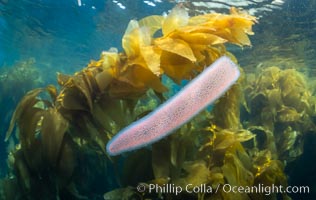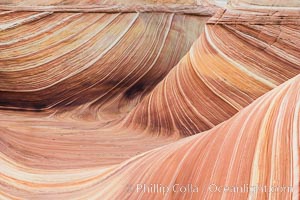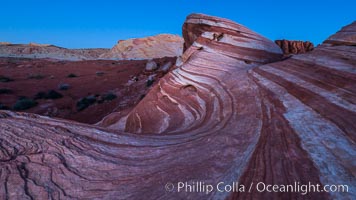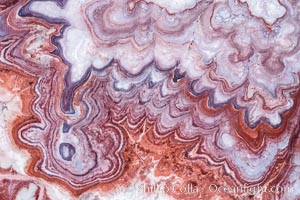
Pyrosome drifting through a kelp forest, Catalina Island. Pyrosomes are free-floating colonial tunicates that usually live in the upper layers of the open ocean in warm seas. Pyrosomes are cylindrical or cone-shaped colonies made up of hundreds to thousands of individuals, known as zooids.
Location: Catalina Island, California
Image ID: 37164
Location: Catalina Island, California
Image ID: 37164

The Fire Wave, a beautiful sandstone formation exhibiting dramatic striations, striped layers in the geologic historical record.
Location: Valley of Fire State Park, Nevada
Image ID: 26487
Location: Valley of Fire State Park, Nevada
Image ID: 26487

Navajo sandstone forms the cliffs and walls of Zion National Park. The sandstone reaches a thickness of 2300 feet and consists of ancient cemented desert sand dunes. Horizontal lines, commonly called crossbedding, represent layers of wind-blown sand that built up into sand dunes. These dunes were then buried, and the sand grains glued together by calcite and iron oxide to form sandstone.
Location: Zion National Park, Utah
Image ID: 12519
Location: Zion National Park, Utah
Image ID: 12519

The Wave, an area of fantastic eroded sandstone featuring beautiful swirls, wild colors, countless striations, and bizarre shapes set amidst the dramatic surrounding North Coyote Buttes of Arizona and Utah. The sandstone formations of the North Coyote Buttes, including the Wave, date from the Jurassic period. Managed by the Bureau of Land Management, the Wave is located in the Paria Canyon-Vermilion Cliffs Wilderness and is accessible on foot by permit only.
Location: North Coyote Buttes, Paria Canyon-Vermilion Cliffs Wilderness, Arizona
Image ID: 20609
Location: North Coyote Buttes, Paria Canyon-Vermilion Cliffs Wilderness, Arizona
Image ID: 20609

Sunrise lights sandstone rocks, Valley of Fire.
Location: Valley of Fire State Park, Nevada
Image ID: 28444
Location: Valley of Fire State Park, Nevada
Image ID: 28444

Sunrise lights sandstone rocks, Valley of Fire.
Location: Valley of Fire State Park, Nevada
Image ID: 28445
Location: Valley of Fire State Park, Nevada
Image ID: 28445

Sunrise lights sandstone rocks, Valley of Fire.
Location: Valley of Fire State Park, Nevada
Image ID: 28446
Location: Valley of Fire State Park, Nevada
Image ID: 28446

The Fire Wave at night, lit by the light of the moon.
Location: Valley of Fire State Park, Nevada
Image ID: 28430
Panorama dimensions: 7280 x 7255
Location: Valley of Fire State Park, Nevada
Image ID: 28430
Panorama dimensions: 7280 x 7255

Fantastic colorful sedimentary patterns, Bentonite layers are seen as striations exposed in the Utah Badlands, part of the Brushy Basin shale member of the Morrison Formation. This layer was formed during Jurassic times when mud, silt, fine sand, and volcanic ash were deposited in swamps and lakes. Aerial photograph.
Location: Utah
Image ID: 38019
Location: Utah
Image ID: 38019

Fantastic colorful sedimentary patterns of Bentonite layers, seen as striations exposed in the Utah Badlands. The Bentonite Hills are composed of the Brushy Basin shale member of the Morrison Formation formed during Jurassic times when mud, silt, fine sand, and volcanic ash were deposited in swamps and lakes into layers, now revealed through erosion. Aerial photograph.
Location: Utah
Image ID: 38067
Location: Utah
Image ID: 38067

The Tree of Eons, Utah. The Tree of Eons is a spectacular geologic sight near the San Rafael Swell in Utah. Here the Tree of Eons is seen under the direct light of midday. Erosion has cut a dendritic "tree" through red, blue, purple and white layers of the Chinle formation. The Tree of Eons is a superb example of dendritic erosion and, to really appreciate its complex fractal-like details, must be observed from above.
Location: Utah
Image ID: 38201
Location: Utah
Image ID: 38201

The Great Wall, Navajo Tribal Lands, Arizona. Sandstone "fins", eroded striations that depict how sandstone -- ancient compressed sand -- was laid down in layers over time. Now exposed, the layer erode at different rates, forming delicate "fins" that stretch for long distances.
Location: Navajo Tribal Lands, Page, Arizona
Image ID: 26644
Location: Navajo Tribal Lands, Page, Arizona
Image ID: 26644

Milky Way galaxy rises above the Fire Wave, Valley of Fire State Park.
Location: Valley of Fire State Park, Nevada
Image ID: 28555
Location: Valley of Fire State Park, Nevada
Image ID: 28555

The Wave in the North Coyote Buttes, an area of fantastic eroded sandstone featuring beautiful swirls, wild colors, countless striations, and bizarre shapes set amidst the dramatic surrounding North Coyote Buttes of Arizona and Utah. The sandstone formations of the North Coyote Buttes, including the Wave, date from the Jurassic period. Managed by the Bureau of Land Management, the Wave is located in the Paria Canyon-Vermilion Cliffs Wilderness and is accessible on foot by permit only.
Location: North Coyote Buttes, Paria Canyon-Vermilion Cliffs Wilderness, Arizona
Image ID: 28609
Location: North Coyote Buttes, Paria Canyon-Vermilion Cliffs Wilderness, Arizona
Image ID: 28609

The Second Wave at sunset. The Second Wave, a curiously-shaped sandstone swirl, takes on rich warm tones and dramatic shadowed textures at sunset. Set in the North Coyote Buttes of Arizona and Utah, the Second Wave is characterized by striations revealing layers of sedimentary deposits, a visible historical record depicting eons of submarine geology.
Location: North Coyote Buttes, Paria Canyon-Vermilion Cliffs Wilderness, Arizona
Image ID: 28615
Location: North Coyote Buttes, Paria Canyon-Vermilion Cliffs Wilderness, Arizona
Image ID: 28615

The Wave at Night, under a clear night sky full of stars. The Wave, an area of fantastic eroded sandstone featuring beautiful swirls, wild colors, countless striations, and bizarre shapes set amidst the dramatic surrounding North Coyote Buttes of Arizona and Utah. The sandstone formations of the North Coyote Buttes, including the Wave, date from the Jurassic period. Managed by the Bureau of Land Management, the Wave is located in the Paria Canyon-Vermilion Cliffs Wilderness and is accessible on foot by permit only.
Location: North Coyote Buttes, Paria Canyon-Vermilion Cliffs Wilderness, Arizona
Image ID: 28624
Location: North Coyote Buttes, Paria Canyon-Vermilion Cliffs Wilderness, Arizona
Image ID: 28624

Pyrosome drifting through a kelp forest, Catalina Island. Pyrosomes are free-floating colonial tunicates that usually live in the upper layers of the open ocean in warm seas. Pyrosomes are cylindrical or cone-shaped colonies made up of hundreds to thousands of individuals, known as zooids.
Location: Catalina Island, California
Image ID: 37163
Location: Catalina Island, California
Image ID: 37163

Panorama of the Wave. The Wave is a sweeping, dramatic display of eroded sandstone, forged by eons of water and wind erosion, laying bare striations formed from compacted sand dunes over millenia. This panoramic picture is formed from thirteen individual photographs.
Location: North Coyote Buttes, Paria Canyon-Vermilion Cliffs Wilderness, Arizona
Image ID: 20702
Panorama dimensions: 4617 x 17432
Location: North Coyote Buttes, Paria Canyon-Vermilion Cliffs Wilderness, Arizona
Image ID: 20702
Panorama dimensions: 4617 x 17432

Striated sandstone formations, layers showing eons of geologic history.
Location: Valley of Fire State Park, Nevada
Image ID: 26476
Location: Valley of Fire State Park, Nevada
Image ID: 26476

Striated sandstone formations, layers showing eons of geologic history.
Location: Valley of Fire State Park, Nevada
Image ID: 26479
Location: Valley of Fire State Park, Nevada
Image ID: 26479

Sandstone details, red rocks, Valley of Fire.
Location: Valley of Fire State Park, Nevada
Image ID: 28447
Location: Valley of Fire State Park, Nevada
Image ID: 28447

The Fire Wave at night, lit by the light of the moon.
Location: Valley of Fire State Park, Nevada
Image ID: 28434
Location: Valley of Fire State Park, Nevada
Image ID: 28434

Elephant arch and stars at night, moonlight, Valley of Fire State Park.
Location: Valley of Fire State Park, Nevada
Image ID: 28438
Location: Valley of Fire State Park, Nevada
Image ID: 28438

The Fire Wave by Moonlight, stars and the night sky, Valley of Fire State Park.
Location: Valley of Fire State Park, Nevada
Image ID: 28439
Panorama dimensions: 4140 x 7360
Location: Valley of Fire State Park, Nevada
Image ID: 28439
Panorama dimensions: 4140 x 7360

Exuberant hiker atop the Fire Wave, at night, stars and the evening sky.
Location: Valley of Fire State Park, Nevada
Image ID: 28450
Location: Valley of Fire State Park, Nevada
Image ID: 28450

Fantastic colorful sedimentary patterns, Bentonite layers are seen as striations exposed in the Utah Badlands, part of the Brushy Basin shale member of the Morrison Formation. This layer was formed during Jurassic times when mud, silt, fine sand, and volcanic ash were deposited in swamps and lakes. Aerial photograph.
Location: Utah
Image ID: 38020
Location: Utah
Image ID: 38020

Fantastic colorful sedimentary patterns, Bentonite layers are seen as striations exposed in the Utah Badlands, part of the Brushy Basin shale member of the Morrison Formation. This layer was formed during Jurassic times when mud, silt, fine sand, and volcanic ash were deposited in swamps and lakes. Aerial photograph.
Location: Utah
Image ID: 38021
Location: Utah
Image ID: 38021

Fantastic colorful sedimentary patterns, Bentonite layers are seen as striations exposed in the Utah Badlands. The Bentonite Hills are composed of the Brushy Basin shale member of the Morrison Formation. This layer was formed during Jurassic times when mud, silt, fine sand, and volcanic ash were deposited in swamps and lakes. Aerial photograph.
Location: Utah
Image ID: 38030
Location: Utah
Image ID: 38030

Fantastic colorful sedimentary patterns of Bentonite layers, seen as striations exposed in the Utah Badlands. The Bentonite Hills are composed of the Brushy Basin shale member of the Morrison Formation formed during Jurassic times when mud, silt, fine sand, and volcanic ash were deposited in swamps and lakes into layers, now revealed through erosion. Aerial photograph.
Location: Utah
Image ID: 38047
Location: Utah
Image ID: 38047
